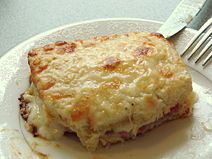Croque-monsieur: Difference between revisions
imported>Peter Schmitt (variations) |
imported>Hayford Peirce (You beat me to it.) |
||
| Line 7: | Line 7: | ||
The original recipe uses ''jambon maigre'' (ham) and ''gruyère'' (cheese). | The original recipe uses ''jambon maigre'' (ham) and ''gruyère'' (cheese). | ||
Variations replace the ham with chicken, use gouda as cheese, add a slice of a tomato, or a slice of a pineapple. | Variations replace the ham with chicken, use gouda as cheese, add a slice of a tomato, or a slice of a pineapple. | ||
A croque-monsieur covered by a fried egg (''avec un œuf sur le plat à cheval'') is called '''croque-madame'''. | A croque-monsieur covered by a fried egg (''avec un œuf sur le plat à cheval'') is called '''croque-madame'''. A simple variation that contains no ham is also generally called a croque-madame. | ||
The 1960 English edition of the ''[[Larousse Gastronomique]]'' says that this is "a rather fantastic name for a kind of hot sandwich which is served as an hors d'oeuvre or as a small entrée. It can also feature in the list of small dishes for lunch, tea, etc."<ref>''Larousse Gastronomique'', first English edition, Paul Hamlyn, London, 1961, page 324</ref> The ''Larousse'' recipe for croque-monsieur is a very simple one, in which an ordinary ham and cheese sandwich is fried "till golden in a frying pan in [[clarified butter]]."<ref>''ibid.''</ref> | The 1960 English edition of the ''[[Larousse Gastronomique]]'' says that this is "a rather fantastic name for a kind of hot sandwich which is served as an hors d'oeuvre or as a small entrée. It can also feature in the list of small dishes for lunch, tea, etc."<ref>''Larousse Gastronomique'', first English edition, Paul Hamlyn, London, 1961, page 324</ref> The ''Larousse'' recipe for croque-monsieur is a very simple one, in which an ordinary ham and cheese sandwich is fried "till golden in a frying pan in [[clarified butter]]."<ref>''ibid.''</ref> | ||
Revision as of 18:05, 6 August 2010

An elaborate version of a croque-monsieur, with gruyère cheese and a béchamel sauce, that has been both baked and broiled.
A croque-monsieur is the French version of the standard grilled ham and cheese sandwich but frequently is far more elaborately structured by the addition of a mornay or béchamel sauce. The simpler versions are grilled, but the elaborate ones with an additional sauce are generally baked or broiled at some stage in their preparation. It is the prototypical lunch or snack in a French café or bar but can also be found on the menus of bistros and brasseries. The origin of the name is uncertain and far from obvious: the verb croquer means to scrunch or crunch (or to sketch a drawing), and monsieur can mean mister, sir, or gentleman—the two words conjoined would seem to have little relevance to a hot sandwich.
The original recipe uses jambon maigre (ham) and gruyère (cheese). Variations replace the ham with chicken, use gouda as cheese, add a slice of a tomato, or a slice of a pineapple. A croque-monsieur covered by a fried egg (avec un œuf sur le plat à cheval) is called croque-madame. A simple variation that contains no ham is also generally called a croque-madame.
The 1960 English edition of the Larousse Gastronomique says that this is "a rather fantastic name for a kind of hot sandwich which is served as an hors d'oeuvre or as a small entrée. It can also feature in the list of small dishes for lunch, tea, etc."[1] The Larousse recipe for croque-monsieur is a very simple one, in which an ordinary ham and cheese sandwich is fried "till golden in a frying pan in clarified butter."[2]
The first croque-monsieur was served in 1910 in Paris, in a café on the boulevard des Capucines[3]